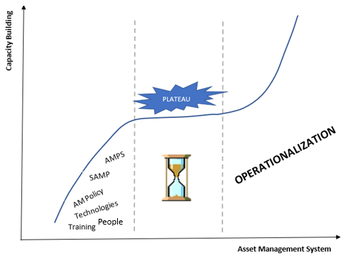 In my last blog I wrote about Coordination vs Integration. This time it is about Implementation vs Operationalization. Why? Well lately I have been hearing the word “operationalization” quite a lot in the asset management realm. Or maybe it is just me. Regardless I wanted to make sure we understand its exact meaning and the difference with implementation. Let's make sure we all understand what “operationalization” entails and its implication rather than just being another “buzz word”. During my career I have seen quite a lot of time where buzz words or terms are used just because they are the latest trends. Is “operationalization” the next asset management fad? Or do we really mean it? Well, if it is the latter, we better make sure we know what to do with it. I was doing some searches on the difference between implementation and operationalization, and I came across this: Should Strategies be Implemented or Operationalized, and what’s the Difference? What is striking is the statement “most strategies should be operationalized, particularly strategies that are more transformational and that a set of conditions need to be in place in order to make operationalizing strategy successful”. The article further explains that operationalizing entails significant transformation of the organization and organizations can behave in unpredictable ways when attempts are made to change them. And operationalizing asset management requires transforming the organization’s dynamics with deeper cross-departmental interaction and engagement. It requires changing mindset, behaviors, and better interoperability. See blog: Is Coordinated Activity Sufficient Enough? Lately I have been raising the flag that we have reached a plateau and focusing too much on strategies, plans and tools and we are not doing enough on execution. In my book Organization-Wide Physical Asset Management-A Systems Approach (Chapter 8, Page 91) I wrote about this issue and the challenges involved. Furthermore the OWPAM® Approach that I developed is intended to help organizations navigate through and apply an operationalization process for their asset management system. What does that mean for you, asset management practitioners? What will be your operationalization approach? Is it going to be the “push” approach or the “pull” approach?
151 Comments
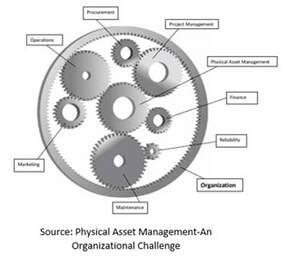 Here I am again with another brain teasing question. I like those type of questions because it makes us think differently rather than thinking like everybody else. It allows us to question the way we are doing things and asking ourselves if what we are doing is good enough or should we change things around to get different results. Well, let’s get to the point. Is coordinated asset management activity in organizations sufficient to realize value from assets? This is based on the definition of asset management as per ISO 55000 standards. By definition “Coordinate” means to bring the different elements of a complex activity or organization into a relationship that will ensure efficiency or harmony. We all agree that asset management consists of different elements and organizations are complex entities. As an asset management practitioner, over the years I have noticed that coordinating activities can only achieve so much. We do achieve a lot at the tactical and operational levels, but we know that the scope of asset management is much more than that based on the context of the organization. At the strategic level, asset management involves leadership, commitment, strategic planning, alignment, among other things. At that level coordinated activity will not cut it. I came to this conclusion when we were rolling out our asset management policy and its guiding principles across the organization. Similarly establishing and operationalizing a strategic asset management plan and other departmental asset management plans require more than just coordinating activities. It requires transforming the organization’s dynamics with deeper cross-departmental interaction and engagement. It requires changing mindset, behaviors and better interoperability. It entails taking an integrated approach. An integrated approach helps to navigate the complexity of organizations and the existing interdependencies, blend the different priorities, and foster collaboration among functional areas to make timely and optimal decisions. By definition “Integrate” means to combine (one thing) with another so that they become a whole. The essential difference between integration and coordination is that integration implies a fusion of components into something new, while coordination is the arrangement of roles and tasks into an organized whole. As philosopher G. W. F. Hegel put it – “The truth is in the whole”. From an asset management perspective everybody doing their best and coordinating their activities are not good enough. The truth is in the something new that we are developing – the asset management system spanning across the whole organization from top to bottom and cross-departmental. How does an asset management system look like? Do you have a visual model of it? Would coordinating activities be enough to build that model or should we “integrate and coordinate asset management activities across the organization to realize value from assets”? 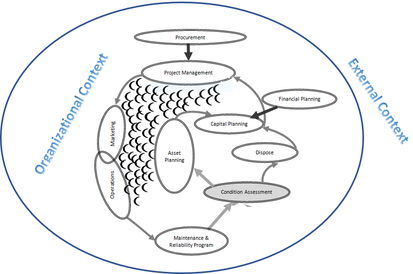 The chicken or the egg causality dilemma stems from the observation that all chickens hatch from eggs and all chicken eggs are laid by chickens. "Chicken-and-egg" is a metaphoric adjective describing situations where it is not clear which of two events should be considered the cause and which should be considered the effect, to express a scenario of infinite regress, or to express the difficulty of sequencing actions where each seems to depend on others being done first. (Source: https://en.wikipedia.org/wiki/Chicken_or_the_egg) What am I talking about and what this has to do with asset management? Well, it has a lot to do. Let me explain. The chicken is the “asset management system” and the egg is “value”. Do we develop our asset management system and be patient to realize value or do we just start measuring and reporting on value while hoping the existing system will continue to deliver? In many organizations we are observing that the focus is on “how to realize value” without focusing enough on developing and implementing the asset management system that would deliver value. It is taken for granted that the asset management system will happen by itself with the strategies, plans, technologies, and people in place. But let me tell you it is not going to happen on its own. Let’s not get our organization held up by the law of inertia. We need that extra outside force to cause the change, the transformation. We need to diligently act on the current system, and this is the most difficult part. Implementing well developed strategies and plans in a chaotic environment is not going to be successful. It is going to be an inefficient way of spending time, effort, and money without significant progress. What we need is a more radical transformation to move to an effective asset management system to realize value. Consider the seven requirements of an asset management system that must be dealt with as prescribed in the ISO 55000 suite of standards:
Make no mistake, building an asset management system is a very complex undertaking. It is an extremely daunting task especially when you place it in the context of your own organization, the prevailing culture and other challenges that come with it. Is this the reason why we prefer to turn a blind eye to some of those requirements and instead focus on the easier tasks such as strategies, plans, tools, and technologies? Do we really have the desire to rattle the cage or just simply settle for the minimum? Do we want to just keep accepting the few eggs and let the chicken die or do we want to feed and nurture the chicken to reap more eggs for a longer time? Asset management practitioners and organizational leaders – let’s be bold enough to rattle the cage and overcome the inertia. Dropping strategies, plans and tools on our laps in a chaotic environment is not going to cut it. Implementing and operationalizing an effective asset management system is even trickier as it is embedded in a complex organizational system with complex people systems busy with their own specific activities and all surrounded with numerous ever-changing complex external systems. To overcome the inertia and transform your organization to implement an effective asset management system, systems thinking is warranted. A chaotic or self-evolving approach will result in killing the chicken over time without having the opportunity to harvest maximum eggs for many years to come. So what should be your focus – the chicken or the egg? I will leave it to you to decide.  It has been exactly a year since I launched the HPAM Board Game. An interactive asset management board game to better understand the challenges of implementing asset management based on my first book – Physical Asset Management – An Organizational Challenge. Thank you to Terry O’Hanlon and Maura Abad at Reliability web for believing in the Game and provided me the opportunity at IMC-2018. Over the year I have collected lots of feedback and suggestions. One of the comments that inspired me was: “Can I buy one set to gift to my Manager?” With that in mind I worked on several improvements to the Board Game to make it not only fun but something more valuable to Organizations and to asset management practitioners on their asset management journey. Yes, asset management is a journey – a journey that will require of course the coordination of activities but more importantly collaboration of the different functional areas. The HPAM Board Game brings everyone in the organization together in one room, to educate them on the asset management activities, to make them understand the importance of ownership and involvement and be aware of the implementation challenges. It is a board game that is played physically in a meeting room combined with an online application to generate results and analysis. The HPAM Game is a key key element of the HPAM Process. It is one of the first steps in an Organization’s journey to implement an organization-wide physical asset management system. Gift your Organization the HPAM Game now. What better way to kick starts your HPAM journey in 2020! The Game is available for pre-order at www.hpamsolutions.com Be the first ones to try it out. The first 10 orders will receive a gift. 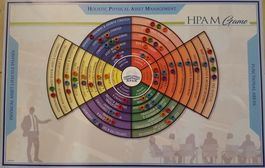 The HPAM Game® is a board game based on my first book “Physical Asset Management - An Organizational Challenge”. It is a highly interactive team approach game developed to better understand the challenges organizations face on their path to implementing organization-wide holistic physical asset management. The objective of the game is to look at the key physical asset lifecycle strategic & tactical activities and match them with corresponding key functional areas of the organization. It helps Organizations to:
The HPAM Game® is delivered in a full-day workshop format and will be launched on December 14, 2018 at IMC2018 in Florida. If you are attending IMC 2018 I highly recommend you attend the HPAM Game workshop where you will have the opportunity to explore the challenges of organization-wide physical asset management with your peers and get a complimentary copy of the book “Physical Asset Management - An Organizational Challenge”. If you are not attending IMC 2018 and have not read the book yet, I recommend you get a copy of it, available at https://www.dharmendhaliah.com/bookstore.html or via HPAM on Amazon: https://www.amazon.ca/gp/offer-listing/1460288262/ref=tmm_pap_new_olp_sr?ie=UTF8&condition=new&qid=&sr= Do check my website for future offerings/venues of the HPAM Game in 2019 and follow HPAM going forward…some interesting stuff in the making. 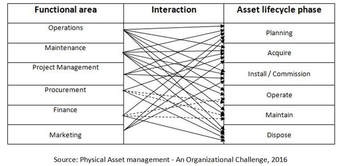 After several months of absence, I am finally back to posting my blogs. I have been busy working on a few concepts which I will shortly introduce. As mentioned in my earlier blogs, managing physical assets requires a holistic approach, not only from a whole lifecycle phase perspective but also from an organizational perspective (I call it HPAM – refer to my blog dated January 8, 2017). Many organizations currently experience the silo syndrome, which can result in a chaotic situation when managing physical assets. This situation is illustrated in the figure below, which was taken from my book. The left-hand side has the different functional areas of an organization and on the right-hand side you have the different phases of an asset lifecycle. All these elements are closely interrelated with each other, with different levels of interaction between them, creating a complex system. It’s important to understand that we should not look at physical asset management through the lenses of individual functional silos nor through specific asset lifecycle phases, but in an organization-wide or enterprise-wide asset management approach. So what actually is Organization-wide Physical Asset Management and how do you implement it? Well as mentioned above, I have been working on a couple of projects, which I hope will help organizations better understand and apply the concept of organization-wide physical asset management. Below is a brief overview of the two concepts:
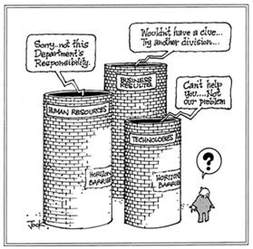 Every time we talk about operationalizing whole lifecycle asset management there is a term that is constantly referred to – organizational silos. It sounds like it is a common problem in many organizations when it comes to implementing a holistic asset management philosophy. So what are organizational silos? Are they really a problem? How do we overcome them? In one of my previous blogs when I talked about theory of constraints I mentioned that ‘organizational silos’ is indeed a constraint. In my book I dedicated a full page (it should have been more, now that I think of it) on organizational silos. So what are they and are they really that bad? In many literature and articles there is mention of breaking down those silos or even of shattering them. But how do we do that and will that resolve the issue on hand? Before talking about breaking silos down or shattering them, we should understand why they actually exist in the first place. They are obviously not a natural occurrence. They were created on purpose as a form of management style via organizational structures and specialized job designs to segregate the various governance mechanisms into functional enclaves, where technical specialist work independently of the other functions. However what ended up happening is that organizations get caught in a functional silo syndrome where there is a lack of mutual concern and cohesion. Individuals ingenuity is wasted, groups are not collaborating and there is no shared vision for people to rally around. Gillian Tett put it brilliantly in her book, The Silo Effect: “Silos can be useful but also dangerous. They have the power to collapse companies and destabilize financial markets, yet they still dominate the workplace. They blind and confuse us, often making modern institutions collectively act in risky, silly, and even stupid ways.” The functional enclaves (e.g. finance, operations, maintenance, project management, marketing, etc.) should consider how the techniques that they develop within their own function might work together with the other functions. It would also be helpful if they consider how they jointly might be able to develop better ways to balance conflicting objectives to meet the organizational strategic goals. Can you recognize the functional silo(s) in your organization? Can you recognize the silo effects prevailing? Can you think of ways to overcome those silo effects?  While considerable progress has been made by many municipalities with respect to developing and implementing asset management plans, there are still quite a lot to accomplish. A few years ago we were hit with the blitz of ISO 55000. Since then there has been lots of buzz in the asset management field. Now there is another blitz coming – the regulation of asset management planning. The Province of Ontario, Canada has recently proposed an Asset Management Planning Regulation. The draft of the proposed regulation is in its final stage after a final round of call for feedback and comments. . Asset Management regulation is not new. In New Zealand AM legislation has been in place since 1996 at the Local Government level. In Australia state-based utility regulators expect best practice AM techniques and require regular audits and reporting. In Britain the regulation of national infrastructure is a bit different. In Ontario, Canada it is a first, even though great asset management practices are in place in different provinces across the country. So what is the purpose of this upcoming asset management planning regulation? The main reasons are to introduce new requirements in order to:
We all know very well that “A plan remains a plan unless it is put in action”, i.e. unless it is operationalized. In the proposed regulation draft it clearly stipulates that “while municipalities have made excellent progress in asset management planning, significant differences exist among municipalities in the completeness, level of detail, and methodology and assumptions used to develop the plans. The plans also vary widely in the degree to which they are being used to inform decision making”. Operationalizing by definition means setting something up (your asset management plan), so that it can be used, used not only by a few functional areas but across the whole organization. This is where HPAM comes into the frame - not holistic approach from an asset whole lifecycle perspective only, but from a whole- organizational perspective as well. This means having all functional areas dealing with assets in one way or another to fully understand, endorse and implement the AM plan in their respective areas. As you can imagine, this is not an easy feat because we are now dealing with an Enterprise-Wide Asset Management Program. How well is your asset management plan understood, endorsed and implemented in the different functional areas of your organization? 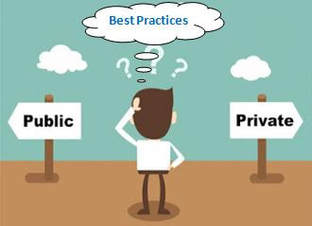 .There is this ongoing discussion about asset management in the public sector and the private sector. The debate is about who is doing the “real” asset management stuff and where can we find the best practices. The topic is even more prominent now, especially with its global magnitude. It is being discussed in various conferences, training programs, publications and messages from consultants/vendors. Is one doing asset management and the other doing strategic asset planning? Is one better than the other? At the end of the day in my opinion this is a futile discussion. If we look closely at both, the public and private sectors, they are both doing their part the best they can within their respective organizational context. Rather than getting into the debate of who is doing better, we should be focusing more on how each of these sectors can share and improve their processes to achieve a more holistic asset management approach. Maybe the strategic portion is in place (top down approach), but not the tactical portion (bottom up approach) or vice versa - vertical alignment. Maybe organizations are doing the right things but in functional silos with poor collaboration – horizontal alignment. Ultimately, what really matters most is how well the approaches/activities are aligned and coordinated. Of course there will always be areas of misalignment or weaknesses (constraints) that will need to be revisited. Of course there will always be gaps in processes, which are great opportunities for improvement. What is the difference then, and why the ongoing debate? In the public sector asset management planning is traditionally performed by the asset management/finance function with council endorsement. Engineering and public works take care of the asset management tactics in the form of refurbishments and routine maintenance. In the private sector where the organizational context is different, asset management planning is usually done by senior management and endorsed by the shareholders or executive boards. Engineering and maintenance & reliability execute the asset management tactics. So what does that mean? Well in the private sector strategic asset planning is done at the board level and is pushed down to staff to execute the strategic direction, e.g. the board decides to expand the plant by next year in order to launch a new product. Market research and analysis have been completed, funding has already been arranged and decision has been made to stop manufacturing the old product, with all the related assets identified for disposal. All the related tactical projects need to be executed as per the approved plan and business priorities to generate maximum returns. In this case the tactical portion is very visible, while the principal-agent discussion is conducted behind closed doors. Hence we have the perception that “asset management planning” does not exist or is not carried out. In the public sector it is actually a different approach. Council discussion and decision is public information – meaning we not only get to see more of the “asset management planning” and budgeting process, but we can also have our say and input. There are more open debates at the planning stage because of the political nature and impact of projects. Once decisions have been reached, then the actual execution is passed over to engineering/public works. So both, the public and private sectors practice asset management based on their existing organizational context. As stated in ISO 55002, understanding the organization and its external and internal context is key in defining the scope of an organization’s asset management system, which will be used to set out the approach to enable the delivery of the organizational objectives. With the changing landscape in asset management globally, organizations are now required to take a more holistic approach to manage their assets – both from a whole lifecycle perspective as well as enterprise-wide. So let us share and learn more from each other to make it happen.  In several asset management literatures I have been seeing terms such as demand analysis, demand management and need analysis being used. I was a little curious to understand how these terms relate to Asset Management, the difference and linkages between them and most importantly when to use them. A good place to start is to understand what each term exactly means. A quick search on the internet gave the following definitions: • Demand Analysis: Research into the desire of consumers for a particular product or service. Demand analysis is used to identify who wants to buy a given product, how much they are likely to pay for it, how many units they might purchase, and other factors that can be used to determine product design, selling cost, and advertising strategy for a product. http://www.investorwords.com/16338/demand_analysis.html#ixzz4nBkb8TEB • Demand management: Demand management is a planning methodology used to forecast, plan for and manage the demand for products and services. This can be at macro-levels as in economics and at micro-levels within individual organizations. https://en.wikipedia.org/wiki/Demand_management • Needs Analysis: Need Analysis is the process of identifying and evaluating needs in a community or other defined population of people. The identification of needs is a process of describing “problems” of a target population and possible solutions to these problems. Some people use the related term “needs assessment” or “needs identification”. A need may be different from such related concepts as wants (“something people are willing to pay for”) or demands (“something people are willing to march for”). (McKillip, 1987) https://extension.arizona.edu/evaluation/sites/extension.arizona.edu.../files/.../needs.pdf It can be pretty confusing when you consider needs, wants and demands. From an article by Walter White - Needs, wants and demands are all marketing concepts and play a vital role in terms of marketing management. They help us build a strong relationship with the customer – customer level of service. How does all this apply to asset management? For example when I implement asset management do I start with demand analysis or need analysis? Why there is no need management, while we do have demand management? Let us start with needs. Needs are all the basic minimum requirements that have to be achieved to meet certain agreed upon level of service as defined by the organizational strategic objectives or by a type of legislation. For example: The need for safe roads, which are achieved by having clear road markings, functional traffic lights, minimum potholes, etc. Since needs may be presented as fait accompli, there is no timing options (meaning it must be fulfilled right away or when it is actually due in the near future). It is the core requirements as listed in any AM Plan to maintain a certain level of service at a certain cost to a certain level of risk. A need analysis may have been carried out to help find different ways of meeting those needs. Demand is more about raising expectations and setting higher levels of service. For example there are demands to improve traffic congestion on this regional road by adding another lane. In this case there are timing options and the demands may not be fulfilled right away before a thorough demand analysis is carried out. A demand analysis will help explore what is needed in the short-term and in the long-term, the different options, their feasibility, how much it will cost and the risks associated with each option. Through the demand analysis it may come up that the demand can be managed without adding another lane. Demand management is an effective tool in influencing the need for a service (to improve traffic congestion) and is an essential part of any effective asset management process in assessing options for the provision of a service. Depending on the types of assets and service being delivered, it may be possible to increase, decrease or contain demand. Different demand management techniques can be applied such as pricing differentiation, market education and service/product differentiation among others. Whenever we use needs, demands or wants we must understand the full context. As a matter of fact in ISO 55002 under the Section "Understanding the needs and expectations of stakeholders" it clearly says that stakeholders are likely to make judgements about the organization's asset management outputs and outcomes based on their perceptions, which can vary due to differences in values, needs, assumptions, concepts and concerns. So next time think about whether you will start with need analysis, demand analysis or demand management in your asset management planning process and in what context. |
FollowAuthorDharmen Dhaliah, P.Eng, MBA, PMP, CAMA, MMP, CMRP Archives
October 2021
Categories |

 RSS Feed
RSS Feed